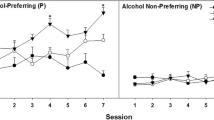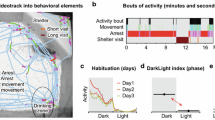Abstract
To determine genetic differences in voluntary morphine consumption, 15 commonly used inbred strains of mice were given ad libitum two-bottle choice between saccharin alone or saccharin/morphine in one bottle and water in the other bottle. Subsequently, the saccharin was gradually reduced to zero, leaving only morphine. Independent groups of mice of the same strains were exposed to quinine in a parallel manner to control for the bitter alkaloid taste of morphine. Of the 15 strains, the C57BL/6J strain showed the highest consumption of morphine, both with or without saccharin and greatest consumption of morphine relative to quinine; it also showed only a slight decline in fluid consumption when morphine was added to the saccharin bottle. In marked contrast, the SWR/J strain showed the least consumption of morphine by the same criteria, followed closely by the AKR/J, CE/J, DBA/2J and SJL/J strains. The strain differences for all the morphine drinking measures exceeded an order of magnitude. Strain-specific voluntary morphine/saccharin consumption was not significantly correlated with saccharin consumption alone, but was highly correlated with morphine consumption alone. The results show that these behaviors are under an unusually large degree of genetic determination, and some of the largest strain differences remained essentially the same regardless of whether saccharin was present, or whether quinine was used as a control tastant.
Similar content being viewed by others
References
Belknap JK (1990) Physical dependence induced by the voluntary consumption of morphine in inbred mice. Pharmacol Biochem Behav 35:311–315
Belknap JK, Crabbe JC (1992) Chromosome mapping of gene loci affecting morphine and amphetamine responses in BXD recombinant inbred mice. In: Kalivas P, Samson H (eds) The Neurobiology of alcohol and drug addiction. Ann NY Acad Sci 654:311–323
Belknap JK, O'Toole LA (1991) Studies of genetic differences in response to opioid drugs. In: Crabbe JC, Harris RA (eds) The genetic basis of alcohol and drug actions. Plenum, NY, pp 225–252
Broadhurst PL (1978) Drugs and the inheritance of behavior. Plenum, NY
Carney JM, Cheng M-S, Wu C, Seale TW (1991) Issues surrounding the assessment of the genetic determinants of drugs as reinforcing stimuli. J Addict Dis 10:163–178
Crabbe JC, Phillips TJ, Kosobud A, Belknap JK (1990) Estimation of genetic correlation: interpretation of experiments using selectively bred and inbred animals. Alcohol Clin Exp Res 14:141–151
Di Chiara G, North RA (1992) Neurobiology of opiate abuse. TIPS Rev 13:185–192
Festing MFW (1989) Inbred strains of mice. In: Lyon MF, Searle AG (eds) Genetic variants and strains of the laboratory mouse. Oxford University Press, Oxford, pp 636–648
Forgie ML, Beyerstein BL, Alexander BK (1988) Contributions of taste factors and gender to opioid preference in C57BL and DBA mice. Psychopharmacology 95:237–244
Fuller JL (1974) Single locus control of saccharin preference in mice. J Hered 65:33–36
Horowitz GP (1981) Pharmacogenetic models and behavioral responses to opiates. In: McClearn GE, Deitrich RA, Erwin VG (eds) Development of animal models as pharmacogenetic tools. NIAAA Res Monogr No 6, USGPO, Washington, DC, pp 209–232
Horowitz GF, Whitney GW, Smith JC, Stephan FK (1977) Morphine ingestion: Genetic control in mice. Psychopharmacology 52:119–122
Khavari KA, Peters TC, Baity PL, Wilson AS (1975) Voluntary morphine ingestion, morphine dependence, and recovery from withdrawal signs. Pharmacol Biochem Behav 3:1093–1096
Koob GF (1992) Drugs of abuse: anatomy, pharmacology and function of reward pathways. TIPS Rev 13:177–192
Lush IE (1984) The genetics of tasting in mice. Genet Res 44:151–16
Meisch RA (1991) Establishment of drug discrimination and drug reinforcement in different animal strains: some methodological issues. J Addict Dis 10:179–188
Phillips TJ, Belknap JK, Crabbe JC (1991) Use of voluntary morphine consumption in recombinant inbred strains to assess vulnerability to drug abuse at the genetic level. J Addict Dis 10:73–88
Samson HH, Harris RA (1992) Neurobiology of alcohol abuse. TIPS Rev 13:206–211
Stolerman I (1992) Drugs of abuse: behavioural principles, methods and terms. TIPS Rev 13:170–176
Wilkinson L (1990) Systat: The System for Statistics. Systat, Evanston, IL
Author information
Authors and Affiliations
Rights and permissions
About this article
Cite this article
Belknap, J.K., Crabbe, J.C., Riggan, J. et al. Voluntary consumption of morphine in 15 inbred mouse strains. Psychopharmacology 112, 352–358 (1993). https://doi.org/10.1007/BF02244932
Received:
Revised:
Issue Date:
DOI: https://doi.org/10.1007/BF02244932




